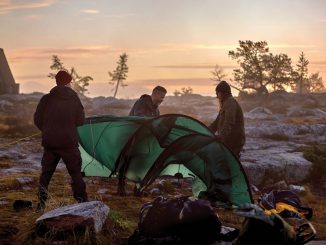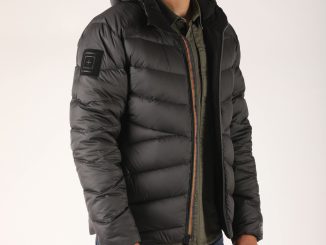
Some people take corporate jobs for the benefits and stability with the goal of climbing the proverbial corporate ladder until they can kick their feet up in retirement. Others see their corporate gig as a steppingstone, using the knowledge, the experience, and the connections prior to starting their own venture. Richard Liu, was of the latter mindset when he left his plush position at a known technology company to pursue his personal passion for design.
What started as a simple concept born from his own personal necessity quickly grew from a single product to a full collection of accessories. Liu merged his interest for design and his affinity for military products to create DSPTCH.

DSPTCH gear is designed from the inside out to be usable, durable and original.
Prior to taking the leap of faith and going all in with the brand, Liu started with a camera strap as his first product and worked out of his apartment, while maintaining a full-time job. These humble beginnings would lay the foundation for the company, which would him lead to eventually opening an office and warehouse before finally leaving his desk job. Five years after conception, the first retail location opened in San Francisco’s emerging Mission District. Two years later, DSPTCH opened a location in New York and a third location and their first international store in Tokyo.
DSPTCH boasts a full line of accessories including a complete collection of bags — all with the purpose of enhancing the carrying experience while protecting your gear. The brand has collaborated with other notable companies including Leica, Reigning Champ, Google, and Equinox. We spoke to Liu about what inspires his designs, the creative process, and the future of DSPTCH.
EDC: For those who aren’t familiar, tell us about your background?
RL: Although I have some roots in art and design, most of my professional experience has been on the business side. I spent my early years in both startup and corporate tech marketing until DSPTCH became enough of an opportunity to switch over full time.

Utility comes before style in DSPTCH’s way of thinking: Form follows function.
EDC: What was your inspiration in starting this brand? Why did you choose the name DSPTCH?
RL: I always had an interest in Mil-Spec items, particularly the story behind why each standard-issue item is designed the way that it is as well as the durability focus of the construction. Our first product was a camera strap, which was produced more from a personal need than for resale. Because of my existing interest in Mil-Spec, I decided to make the strap with the same materials, which led to our founding concept of producing consumer goods with military-grade parts. The name (it’s pronounced “dispatch”) came from this merging of concepts as well as my own interests, being that the concept of a dispatch unit is most widely known for its usage in the military but also has real-life applications as well.
EDC: For the first couple of years you still held your full-time gig. What prompted you to go all in with the brand?
RL: I’m not really sure which led to the other, but ultimately it was a combination of excitement from the early success we had as well as my growing suspicion that I was not going to be able to find longevity in a corporate environment. I decided to give myself a two-year period to work on the company full time and then decide if it was a viable option for the foreseeable future.
EDC: What general steps are involved in your creative process?
RL: The core focus of the company is utility, so my process typically begins with a need. I then decide if I have a solution for that need and then I will spend a few cycles trying alternatives to determine which solution makes the most sense. After I feel like the need has been addressed, I then spend time on additional features, add-ons, durability, and finally whether it can be produced within the confines of our current manufacturing arrangement.

Richard Liu started designing personal accessories for his own use while working in a corporate position. Eventually, he quit his full-time job and followed his passion.
EDC: Are there any key insights that guide your vision?
RL: I believe it is important that each of our products has a clear reason to exist. I try very hard to avoid just making “our version” of a product that already has many solid options in the marketplace. This means that we have to be a bit more purposeful with our designs and make sure we don’t end up spending too much time on something that didn’t really need to be made in the first place.
“I believe it is important that each of our products has a clear reason to exist.”
EDC: How would you describe your design aesthetic, and what influences the style of DSPTCH? How do you select the materials you use?
RL: Our products are focused on utility, so we typically want that to be the first word that comes across someone checking out one of our items. Style-wise, we honestly don’t spend too much time on that since we’re usually pretty far along in the process once we feel satisfied with the functionality of the item. I’m personally inspired a lot by the graphic design world, automobiles, interior design and also sci-fi. The materials are all selected first based on ruggedness, which limits our choices a bit.

EDC: What are the details in your designs that separate your products from others?
RL: I’ve been focusing the past few years on remaining heads down when we design new products, so I honestly don’t feel very well versed with the other options available now in the market. If I was to speak generally on it, I would say there’s a good chance our bag will last longer and will feature more straightforward functionality, but there are also are a lot of other great bags out there that achieve this as well.
EDC: How do you test your product? What do you look for when testing? How many prototypes do you go through before release?
RL: I typically test them first personally and then the people on our design, sales and production teams will give them a go as well. When I’m testing, I’m looking for areas of improvement or possible failure, seams that might give out over time based on the way it was sewn. The number of prototypes can range from 2 to 20, it really depends on the design and how ambitious I want to be with the product.

With stores in San Francisco, New York and Tokyo, DSPATCH has figured out who its customer is.
EDC: What are your goals and expectations for DSPTCH?
RL: To be a timeless bag and accessory company and to make products that are useful to people.
EDC: What are you working on at the moment?
RL: At the moment we’ve been working on simpler silhouettes, things that we can produce with technical fabrics that don’t require a lot of foam or other insert materials. We have a few tote designs that should be coming out in the next few months that I’m personally pretty excited about.
EDC: What other products do you plan on releasing in the future?
RL: No long-term plans at the moment, but in the near term more add-ons for our bags, modular items, and organization products.

Creating long-lasting, timeless-looking accessories is the main goal of Richard Liu’s company.
EDC: For any aspiring designers, do you have any words of wisdom?
RL: My best word of encouragement is to be bold with your perspective and to stick with it in spite of what is currently available in the market. Minimally iterative product or trying to make what you think customers want rarely yields compelling design. Stick to your guns and at the end of the day if it’s something you’re excited to own and use, that’s worthy of the process. EDC
Editor’s note: A version of this article first appeared in the EDC Buyer’s Guide Winter, 2020 print issue of American Survival Guide.





Be the first to comment